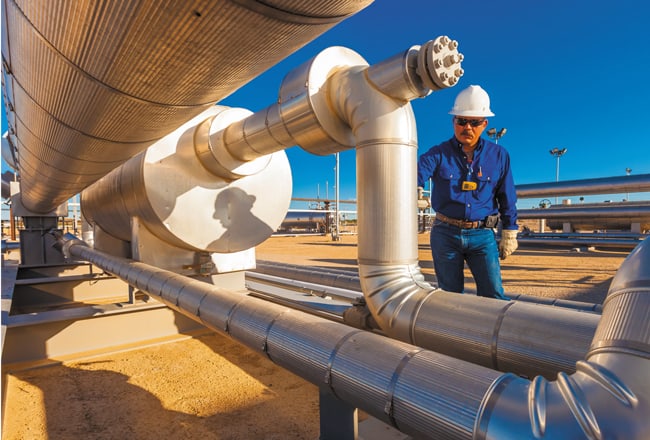AOGR Article: Cloud Suite Eases Complex Logistics

Jeff O’Block, EVP of Commodity Management at W Energy Software, authored a featured article in the American Oil and Gas Reporter Magazine‘s January 2022 digital publication. Titled ‘Cloud Suite Eases Complex Logistics’, O’Block discusses how cloud-based logistics management systems provide real-time information on pricing and product location, simplify transactions and accelerate cash flow.
By Jeff O’Block
From the Permian Basin to the Bakken, the upward tick in crude oil prices is getting the lion’s share of the headlines. Yet with infrastructure bottlenecks being alleviated, record LNG exports, and the long run of low pricing for natural gas and natural gas liquids retreating in the industry’s rearview mirror, natural gas is again an industry darling.
During the early stages of the pandemic, when crude oil demand collapsed, NGL pricing showed resilience. Demand remained strong for propane, one of the main NGLs, because of its many residential and commercial applications, which are as diverse as crop heating. The rest of the NGL mix–ethane, butane, isobutene, and natural gasoline–are major feedstocks for a variety of petrochemical products and fuels that remained in demand even during pandemic shutdowns.
It’s all looking better today. Crude oil demand is rebounding at a steady pace, and natural gas prices are strengthening as well. NGLs’ unique position in providing critical energy needs means renewed emphasis on efficiency and margins as the liquids are condensed from gas streams and moved to market.
Transportation’s Importance
Record NGL demand in the U.S. market and an exploding export market for propane and ethane underscore the need to rapidly transport NGL from the wellhead through the value chain. Price differentials also create an incentive for marketers to move NGL long distances to capitalize on higher prices.
While crude oil production continues to dwarf NGLs, condensates account for about a third of total liquids production in the United States, or more than five million barrels a day according to the U.S. Energy Information Administration. Pipelines provide a partial solution to the NGL transportation problem, with takeaway capacity from the Permian getting a recent boost from the EPIC Crude Oil Pipeline, Gray Oak Pipeline and Cactus 2 Pipeline.
When it comes to moving NGL, crude oil, water or any other commodity, however, there is no monolithic transportation solution. Given the dynamics of the oil field, shifting economics and emerging midstream takeaway bottlenecks, oil field marketing and service providers increasingly will rely on multiple transportation methods to increase optionality and respond to customer demand, including rail, barge and ship. If the United States is a swing producer for the global energy mix, trucks are the swing carrier for the transportation mix, always crucial for their ability to quickly fill takeaway gaps.
Despite the unblocking of many takeaway bottlenecks in the Permian and other basins, trucking remains strong yet presents the industry with challenges. There is the logistical challenge of orchestrating large fleets and large numbers of monthly hauls. There is an environmental, social and governance (ESG) challenge from engine emissions and the risk of spills. And there is the challenge of getting drivers. In a recent report, the American Trucking Association repeated its warning that a nationwide shortage of 80,000 drivers continues to threaten supply chains, making it business critical for carriers to attract and retain workers.

Pipelines remain the safest and most efficient way to transport crude oil, natural gas and natural gas liquids, but to take advantage of price differentials and meet shifting customer demands, producers and marketers are drawing on all forms of transportation, from truck and train to barge and ship. This agility is enabled in part by cloud-based logistics management systems that provide real-time information on pricing and product location, simplify transactions and accelerate cash flow.
From field tickets and bills of lading to dispatch and regulatory bookkeeping, today’s trucking industry remains heavily dependent on paper-based and manual processes. To overcome logistical, environmental and driver challenges, midstream providers are turning to digital transportation management systems (TMS), which comprise specialized enterprise resource planning (ERP) technologies and management processes. For example, one of the largest independent midstream infrastructure companies in North America is leveraging a TMS solution that pairs a mobile app for drivers with a cloud-based ERP purpose-built for oil field carriers.
Midstream service providers who master TMS will unlock substantial benefits, including increased transparency and accuracy into supply chain costs, improved cash flow through accelerated accounting processes and lower fuel usage that improves ESG performance.
To read more, click here to visit the featured interview in The American Oil and Gas Reporter’s January 2022 digital publication.
About W Energy Software
W Energy Software, headquartered in Houston, TX, revolutionizes the oil and gas industry with its leading cloud-based energy platform. Made for upstream and midstream companies, our platform combines advanced software with deep industry knowledge, offering solutions spanning Field Service Management, Production, Accounting, Land, and Transportation. Countless energy professionals turn to W Energy to help their businesses adapt and grow. As the energy industry evolves, so does W Energy, continuously refining our platform to empower today’s needs and tomorrow’s advancements. Visit us at www.wenergysoftware.com to see how we’re shaping the future of energy operations.

Subscribe to Our Insights
Be the first to access blogs, case studies, videos, and more from our experts.